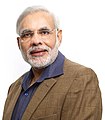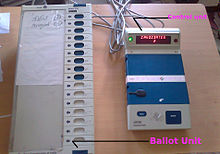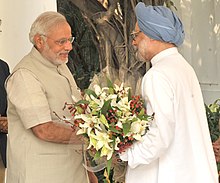General election in India 2014
In the parliamentary elections in India in 2014 , the Lok Sabha , the lower house for the all-Indian parliament, was elected. The election took place over several election dates from April 7, 2014 to May 12, 2014. A total of 543 MPs were elected in individual constituencies according to the relative majority vote . Almost 815 million Indians were eligible to vote, more than the entire European Union, the United States and Russia combined. After the vote count on May 16, 2014, the Bharatiya Janata Party (BJP) and the National Democratic Alliance (NDA) coalition led by it showed a landslide-like victory . The Congress party , which so far led the government, achieved the worst result of any all-India election in the past 60 years. The turnout was 66.4%, higher than in previous elections. The elections for the Vidhan Sabhas , d. H. the regional parliaments of the states of Andhra Pradesh , Arunachal Pradesh , Odisha and Sikkim .
prehistory
The Indian constitution stipulates that the lower house of parliament, the Lok Sabha , must be re-elected every five years. The last election took place in April / May 2009. The election at that time was won by the United Progressive Alliance (UPA) coalition led by the Congress party. The opposition consisted of the Hindu nationalist Bharatiya Janata Party (BJP) and its allies, who had gathered in the National Democratic Alliance (NDA), as well as the left-wing parties of the so-called Third Front and Fourth Front . After the elections, the then 76-year-old economics professor Manmohan Singh formed a coalition government under the leadership of the Congress Party.
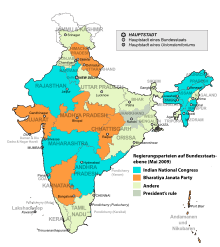
|

|
|
|
Governing parties at the state level immediately after the 2009 election and before the 2014 election. Indian National Congress Bharatiya Janata Party Other President’s rule
|
||
There have been shifts in the balance of power since that last election. The UPA lost its parliamentary majority in 2012/2013 when two coalition partners, the All India Trinamool Congress and the Dravida Munnetra Kazhagam left , and has since been dependent on the tolerance of the Samajwadi Party and the Bahujan Samaj Party . The state elections showed a mixed picture: The Congress Party defended a number of states, but lost the elections in Goa (2012), Delhi and Rajasthan (both 2013) to the BJP. For its part, the BJP defended Gujarat (2012), Madhya Pradesh and Chhattisgarh (both 2013), but lost Uttarakhand , Himachal Pradesh (both 2012) and their southern stronghold of Karnataka (2013) to the Congress Party. In contrast , the election in India's largest state, Uttar Pradesh (2012), which is regarded as important, had a disappointing outcome for both the Congress Party and the BJP. The presidential election on July 19, 2012 was won largely due to disagreement among the opposition by the candidate of the Congress party Pranab Mukherjee .
Campaign issues
The main election campaign issues were slowing economic growth and price increases. While India had annual growth rates of around 8 percent and more in the years 2004 to 2008, growth weakened to less than 5 percent in 2013. Western observers cited deficits in the expansion and maintenance of Indian infrastructure and an inefficient bureaucracy as obstacles to growth. The inflation rate reached 8.3 percent shortly before the elections. In particular, the rise in food and fuel prices had a painful impact on many households. The BJP's top candidate, Narendra Modi , primarily focused on the economic issue during the election campaign and tried to reach voters who are otherwise not close to the BJP. Due to the economic boom in the state of Gujarat , which he ruled since 2001, Modi managed to distinguish himself as a "man of development" ( vikas purush ). In contrast, the BJP avoided classic Hindutva issues in the election campaign, such as the building of the Ram Janmabhumi Temple instead of the Babri Mosque in Ayodhya, which was destroyed by Hindu fundamentalists . In doing so, Modi tried to polish up the negative image that hung on him because of his possible co-responsibility for the anti-Muslim pogroms in Gujarat in 2002.
Another important issue in the election campaign was corruption, which is a serious problem in the Indian political class. The Congress party had to contend with a series of corruption scandals surrounding the UPA government. The largest case in 2010 revolved around the issue of mobile phone licenses by Telecommunications Minister A. Raja . The BJP tried to exploit the congressional government scandals during the election campaign, but was also involved in corruption cases, for example in a 2011 illegal mining scandal in the state of Karnataka . A problem that affected all parties was the criminal machinations of politicians. According to independent critical observers, about 30 percent of all candidates in the current election were pending criminal proceedings. 13 percent of these were serious offenses such as murder, attempted murder, rape, robbery, extortion or kidnapping. Criminal proceedings were also ongoing against 162 of the 543 Lok Sabha MPs in 2009, and 75 cases were serious charges. The desire for a “clean” policy was accordingly great. In 2011, under the leadership of activist Anna Hazare, an extra-parliamentary mass movement against corruption was formed across India. The Aam Aadmi Party (AAP) emerged from part of this movement , and when it first participated in elections in 2013 in the capital city of Delhi, it immediately became the second largest force and briefly formed a minority government. In the election campaign for the all-India parliamentary elections, the AAP, which was competing across India, tried to position itself as an alternative to the existing parties.
Discussions about the establishment of the state of Telangana were a constant domestic political issue . In 2013 the Indian government decided to comply with the ongoing demands from the Telangana region and to separate Telangana from Andhra Pradesh as a separate state with effect from June 2014 . The decision sparked political turmoil in the rest of Andhra Pradesh and led to the resignation of the Andhra Pradesh congressional government and a split within the party. In the election campaign for the Lok Sabha elections, the Telangana question in Andhra Pradesh was the dominant issue.
Rahul Gandhi , leader of the Congress party's election campaign
Narendra Modi , BJP candidate for Prime Minister
Prakash Karat , General Secretary of the Communist Party of India (Marxists)
Party coalitions
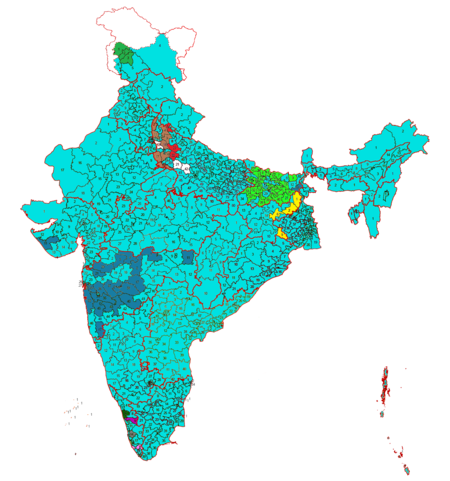

In the election (similar to 2009), several large party alliances faced each other. Relative majority voting promotes the formation of such electoral alliances. In addition to the two major parties, the Congress Party and the BJP, most of the other parties only competed in one or a few states. Exceptions were the two communist parties and the newly founded Aam Aadmi Party.
United Progressive Alliance (UPA)
On January 17, 2014 , the Congress party elected Rahul Gandhi , son of Sonia Gandhi , as campaign leader. However, he was expressly not nominated as a candidate for the post of prime minister. He stated that the members of the newly elected Lok Sabha would have to elect the prime minister, but expressly did not rule out their own candidacy.
The most important allies of the Congress Party were the programmatically related Nationalist Congress Party (NCP) with a focus on Maharashtra, the Rashtriya Janata Dal (RJD) in Bihar , Rashtriya Lok Dal (RLD) in western Uttar Pradesh and the National Conference (JKNC) in Jammu and Kashmir . An agreement was reached between the Congress Party and the NCP, according to which the NCP was reserved 26 of the 48 constituencies in Maharashtra and one of 26 constituencies in Gujarat. The 40 constituencies of Bihar were divided into a joint agreement between the Congress Party, NCP and RJD: 27 for the RJD, 12 for the Congress Party and one for the NCP. Eight constituencies in Uttar Pradesh were reserved for the RLD by the congress party. In Jharkhand , the Congress Party left four constituencies to the allied Jharkhand Mukti Morcha .
National Democratic Alliance (NDA)
The BJP nominated Narendra Modi as its candidate for Prime Minister on September 13, 2013 .
Were the main allies of the BJP Shiv Sena in Maharashtra , Shiromani Akali Dal in Punjab , the three Tamil parties Desiya Murpokku Dravida Kazhagam (DMDK), Pattali Makkal Katchi (PMK) and Marumalarchi Dravida Munnetra Kazhagam (MDMK) in Tamil Nadu and the Telugu Desam Party (TDP) in Andhra Pradesh . Shiv Sena, who represents much more extreme Hindu nationalist positions than the BJP, and Shiromani Akali Dal, who as a nationalist Sikh party is traditional opponent of the Congress Party in Punjab, were to a certain extent natural allies of the BJP. This was not the case with the other parties. Telugu Desam ran in the last election in 2009 as part of the left-wing Third Front and only signed an agreement with the BJP shortly before the start of the current election after negotiations that were not free of tension, after which both agreed on common candidates in Andhra Pradesh. The BJP, which could not win a single constituency in Andhra Pradesh in the last two all-India elections in 2004 and 2009, put candidates in 12 of the 42 constituencies of Andhra Pradesh (eight of them in Telangana), and candidates for the TDP ran in the remaining 30. In Tamil Nadu, the BJP formed an electoral alliance with five Tamil parties, including the MDMK, PMK and DMDK, according to which the DMDK ran in 14 constituencies, the BJP and PMK in eight each and the MDMK in seven. Two more of the 39 constituencies are reserved for small parties (KMDK - Kongunadu Makkal Desia Katchi and IJK - Indhiya Jananayaka Katchi). The MDMK and PMK also ran in the last election in 2009 as part of the Third Front, while DMDK had not joined any coalition.
Communist and other parties of the left political spectrum
Several left-wing parties of the former so-called Third Front reaffirmed their unity in the election campaign on February 25, 2014, without naming a single top candidate. However, campaign agreements were not made everywhere across the country, so that various candidates from left-wing parties faced each other in several constituencies. In West Bengal an arrangement was made within the Left Front , which included the Communist Party (Marxists) (CPM), the Communists (CPI), the Revolutionary Socialist Party (RSP) and the All India Forward Bloc (AIFB). The 42 Bengali constituencies were divided according to the key CPM 32: CPI 3: AIFB 3: RSP 4. A left-wing alliance led by the CPM also formed in Tripura. In Kerala, the Left Democratic Font was formed under the leadership of the two communist parties and other left parties.
Election mode
The election took place in 543 individual constituencies according to the relative majority voting system , i. H. there was only one ballot and the candidate with the highest number of votes won the constituency. The election took place in a total of around 900,000 polling stations. The electoral process was by the Indian Election Commission ( Election Commission of India monitored ECI). As in 2009, votes were not counted using paper ballot papers, but electronically “at the push of a button” using voting machines . The names of the candidates were listed in the main languages and scripts of the constituency concerned. In addition, the candidates were also marked with their party symbol (e.g. the hand for the congress party or the lotus flower for the BJP) so that those who did not know how to read could vote. The voter made his choice by pressing the button next to his candidate's name and symbol. For the first time there was a selection button "NOTA" ( None of the above , "None of the specified") in the current election . The voting machines were battery-operated in order to ensure that they would work even in the event of a power failure or without power. Before they were used on election day, the voting machines were randomly distributed to individual polling stations and tested in the presence or by representatives of the most important political parties. This test was registered by a video surveillance system (CCTV) . The voting machines were then sealed until they were used and given serial numbers, with the candidates from the respective constituency signing the sealing tape.
A connected counter outside the voting booth counted the total votes cast. At the end of election day, the election process was ended by the local election officer by pressing a hidden button. Further votes were then no longer possible. To make it even more difficult to vote twice, a finger was marked with ink after the vote.
Election dates
The election dates were announced by the Indian Election Commission on March 5, 2014. The election took place on 9 days spread over a period of a little more than a month. The final vote count then took place on May 16, 2014.
| States and Union Territories |
electoral circles |
Election dates |
7th of April | 9th April | 10th of April | 12. April | 17th April | April 24th | April, 30th | May 7th | 12th of May |
|---|---|---|---|---|---|---|---|---|---|---|---|
| Andaman and Nicobar Islands | 1 | 1 | - | - | 1 | - | - | - | - | - | - |
| Andhra Pradesh | 42 | 2 | - | - | - | - | - | - | 17th | 25th | - |
| Arunachal Pradesh | 2 | 1 | - | 2 | - | - | - | - | - | - | - |
| Assam | 14th | 3 | 5 | - | - | 3 | - | 6th | - | - | - |
| Bihar | 40 | 6th | - | - | 6th | - | 7th | 7th | 7th | 7th | 6th |
| Chandigarh | 1 | 1 | - | - | 1 | - | - | - | - | - | - |
| Chhattisgarh | 11 | 3 | - | - | 1 | - | 3 | 7th | - | - | - |
| Dadra and Nagar Haveli | 1 | 1 | - | - | - | - | - | - | 1 | - | - |
| Daman and Diu | 1 | 1 | - | - | - | - | - | - | 1 | - | - |
| Delhi | 7th | 1 | - | - | 7th | - | - | - | - | - | - |
| Goa | 2 | 1 | - | - | - | 2 | - | - | - | - | - |
| Gujarat | 26th | 1 | - | - | - | - | - | - | 26th | - | - |
| Haryana | 10 | 1 | - | - | 10 | - | - | - | - | - | - |
| Himachal Pradesh | 4th | 1 | - | - | - | - | - | - | - | 4th | - |
| Jammu and Kashmir | 6th | 5 | - | - | 1 | - | 1 | 1 | 1 | 2 | - |
| Jharkhand | 14th | 3 | - | - | 4th | - | 6th | 4th | - | - | - |
| Karnataka | 28 | 1 | - | - | - | - | 28 | - | - | - | - |
| Kerala | 20th | 1 | - | - | 20th | - | - | - | - | - | - |
| Lakshadweep | 1 | 1 | - | - | 1 | - | - | - | - | - | - |
| Madhya Pradesh | 29 | 3 | - | - | 9 | - | 10 | 10 | - | - | - |
| Maharashtra | 48 | 3 | - | - | 10 | - | 19th | 19th | - | - | - |
| Manipur | 2 | 2 | - | 1 | - | - | 1 | - | - | - | - |
| Meghalaya | 2 | 1 | - | 2 | - | - | - | - | - | - | - |
| Mizoram | 1 | 1 | - | (1) # | - | - | - | - | - | - | - |
| Nagaland | 1 | 1 | - | 1 | - | - | - | - | - | - | - |
| Odisha | 21st | 2 | - | - | 10 | - | 11 | - | - | - | - |
| Pondicherry | 1 | 1 | - | - | - | - | - | 1 | - | - | - |
| Punjab | 13 | 1 | - | - | - | - | - | - | 13 | - | - |
| Rajasthan | 25th | 2 | - | - | - | - | 20th | 5 | - | - | - |
| Sikkim | 1 | 1 | - | - | - | 1 | - | - | - | - | - |
| Tamil Nadu | 39 | 1 | - | - | - | - | - | 39 | - | - | - |
| Tripura | 2 | 2 | 1 | - | - | 1 | - | - | - | - | - |
| Uttar Pradesh | 80 | 6th | - | - | 10 | - | 11 | 12 | 14th | 15th | 18th |
| Uttarakhand | 5 | 1 | - | - | - | - | - | - | - | 5 | - |
| West Bengal | 42 | 5 | - | - | - | - | 4th | 6th | 9 | 6th | 17th |
| Total constituencies | 543 | - | 6th | 6+ (1) # | 91 | 7th | 121 | 117 | 89 | 64 | 41 |
| States / Union territories in which voting took place | 2 | 4+ (1) # | 13 | 4th | 12 | 12 | 9 | 7th | 3 | ||
| Source: Election Commission of India | |||||||||||
# The election in Mizoram was postponed from April 9th to April 11th, 2014.
Course of the election
Until April 12, 2014, the elections went largely according to plan. On April 12, 2014, a Naxalite attack on election workers and police in Chhattisgarh state took place, killing 12 people. On April 24, 2014, a Naxalite bomb attack on a bus carrying police and election workers in eastern Chhattisgarh resulted in eight deaths, and in Kashmir an election worker was shot dead by unknown persons and four others were injured. On April 30, 2014, Narendra Modi cast his vote in his native Vadodara constituency in Gujarat (he was running in two constituencies, also in the holy Hindu city of Varanasi ) and was subsequently accused by the Indian Electoral Commission of breaking the electoral code there he then gave a short political speech and showed party symbols (the lotus flower), which is not allowed under the electoral rules. At the end of April and beginning of May 2014, the long-simmering ethnic conflicts between native Assamese and indigenous peoples and immigrant, mostly Muslim Bengali , flared up again in Assam in the Bodoland region, killing more than 30 people. The Congress Party and the BJP accused each other of being partly responsible for the extent of the violence.
Results
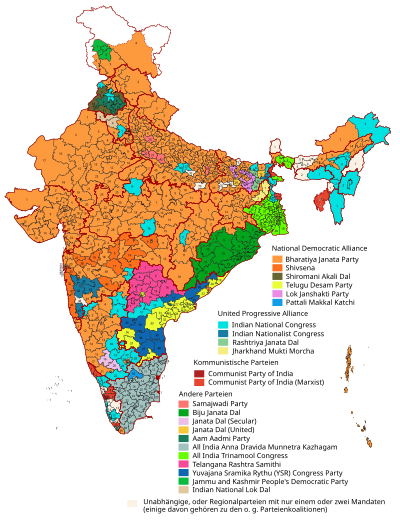
1. National Democratic Alliance Bharatiya Janata Party Shiv Sena (in Maharashtra ) Telugu Desam Party (in Andhra Pradesh ) Lok Janshakti Party (in Bihar ) Shiromani Akali Dal (in Punjab ) Pattali Makkal Katchi (in Tamil Nadu ) 2. United Progressive Alliance Indian National Congress Nationalist Congress Party Rashtriya Janata Dal (in Bihar ) Jharkhand Mukti Morcha (in Jharkhand ) 3rd Communist Parties Communist Party (Marxists) Communist Party of India 4th Other Biju Janata Dal (in Odisha ) Janata Dal (Secular) in Karnataka Aam Aadmi Party All India Trinamool Congress (in West Bengal ) Samajwadi Party (in Uttar Pradesh ) All India Anna Dravida Munnetra Kazhagam (in Tamil Nadu ) Telangana Rashtra Samithi (in Andhra Pradesh ) YSR Congress Party (in Andhra Pradesh ) Jammu and Kashmir People's Democratic Party (in Jammu and Kashmir ) Janata Dal (United) (in Bihar ) Indian National Lok Dal (in Haryana ) Other and Independent
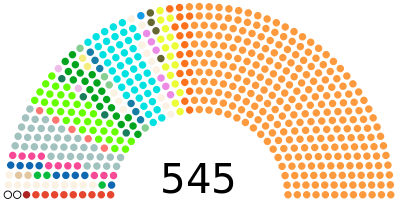
Overall result
On 16./17. May the vote was counted. This resulted in a clear electoral success for the opposition party BJP. In the following table of results only those parties are listed that have received at least one mandate or at least 500,000 votes.
| Political party | Abbreviation | be right | Seats | |||||
|---|---|---|---|---|---|---|---|---|
| number | % | +/- | number | +/- | % | |||
| Bharatiya Janata Party | BJP | 171.660.230 | 31.3% | 12.5% | 282 | 166 | 51.9% | |
| Indian National Congress | INC | 106.935.942 | 19.5% | 9.3% | 44 | 162 | 8.1% | |
| All India Anna Dravida Munnetra Kazhagam | AIADMK | 18,111,579 | 3.3% | 1.6% | 37 | 28 | 6.8% | |
| All India Trinamool Congress | AITC | 21,262,665 | 3.8% | 0.6% | 34 | 15 | 6.3% | |
| Biju Janata Dal | BJD | 9,489,946 | 1.7% | 0.1% | 20th | 6 | 3.7% | |
| Shiv Sena | SHS | 10,262,982 | 1.9% | 0.3% | 18th | 7 | 3.3% | |
| Telugu Desam Party | TDP | 14,099,230 | 2.5% | 16 | 10 | 2.9% | ||
| Telangana Rashtra Samithi | TRS | 6,736,270 | 1.2% | 0.6% | 11 | 9 | 2.0% | |
| Communist Party of India (Marxist) | CPM | 17,988,955 | 3.3% | 2.0% | 9 | 7 | 1.7% | |
| YSR Congress Party | YSRCP | 13,995,435 | 2.5% | (New) | 9 | (New) | 1.7% | |
| Nationalist Congress Party | NCP | 8,635,558 | 1.6% | 0.4% | 6th | 3 | 1.1% | |
| Lok Janshakti Party | LJP | 2,295,929 | 0.4% | 0.1% | 6th | 6 | 1.1% | |
| Samajwadi party | SP | 18,672,916 | 3.4% | 5 | 18 | 0.9% | ||
| Aam Aadmi Party | AAP | 11,325,387 | 2.0% | (New) | 4th | (New) | 0.7% | |
| Rashtriya Janata Dal | RJD | 7,437,464 | 1.3% | 4th | 0.7% | |||
| Shiromani Akali Dal | SAD | 3,636,148 | 0.7% | 0.3% | 4th | 0.7% | ||
| All India United Democratic Front | AIUDF | 2,237,612 | 0.4% | 0.1% | 3 | 2 | 0.6% | |
| Rashtriya Lok Samta Party | RLSP | 1,078,473 | 0.2% | (New) | 3 | (New) | 0.6% | |
| Jammu and Kashmir People's Democratic Party | JKPDP | 732.644 | 0.1% | 3 | 3 | 0.6% | ||
| Janata Dal (United) | JD (U) | 5,992,281 | 1.1% | 0.4% | 2 | 18 | 0.4% | |
| Janata Dal (Secular) | JD (S) | 3,731,481 | 0.7% | 0.1% | 2 | 1 | 0.4% | |
| Indian National Lok Dal | INLD | 2,799,899 | 0.5% | 0.2% | 2 | 2 | 0.4% | |
| Jharkhand Mukti Morcha | JMM | 1,637,994 | 0.3% | 0.1% | 2 | 0.4% | ||
| Indian Union Muslim League | MUL | 1,100,096 | 0.2% | 2 | 0.4% | |||
| Apna Dal | AD | 821.820 | 0.1% | 2 | 2 | 0.4% | ||
| Communist Party of India | CPI | 4,327,460 | 0.8% | 0.6% | 1 | 3 | 0.2% | |
| Pattali Makkal Katchi | PMK | 1,827,566 | 0.3% | 0.2% | 1 | 1 | 0.2% | |
| Revolutionary Socialist Party | RSP | 1,666,380 | 0.3% | 0.1% | 1 | 1 | 0.2% | |
| Swabhimani Paksha | SWP | 1,105,073 | 0.2% | 0.1% | 1 | 0.2% | ||
| Naga People's Front | NPF | 994.505 | 0.2% | 1 | 0.2% | |||
| All India Majlis-e-Ittehadul Muslims | AIMIM | 685.730 | 0.1% | 1 | 0.2% | |||
| National People's Party | NPP | 576,448 | 0.1% | (New) | 1 | (New) | 0.2% | |
| Kerala Congress (M) | KEC (M) | 424.194 | 0.1% | 1 | 0.2% | |||
| All India NR Congress | AINRC | 255.826 | 0.1% | (New) | 1 | (New) | 0.2% | |
| Sikkim Democratic Front | SDF | 163,698 | <0.1% | 1 | 0.2% | |||
| Bahujan Samaj Party | E.G | 22,946,346 | 4.2% | 2.0% | 0 | 21 | 0.0% | |
| Dravida Munnetra Kazhagam | DMK | 9,631,246 | 1.7% | 0.1% | 0 | 18 | 0.0% | |
| Desiya Murpokku Dravida Kazhagam | DMDK | 2,078,843 | 0.4% | 0.4% | 0 | 0.0% | ||
| Jharkhand Vikas Morcha (Prajatantrik) | JVM | 1,567,655 | 0.3% | 0.1% | 0 | 1 | 0.0% | |
| Marumalarchi Dravida Munnetra Kazhagam | MDMK | 1,417,535 | 0.4% | 0.1% | 0 | 1 | 0.0% | |
| All India Forward Bloc | AIFB | 1,211,418 | 0.2% | 0.1% | 0 | 2 | 0.0% | |
| Communist Party (ML) Liberation | CPI (ML) L | 1,007,274 | 0.2% | 0 | 0.0% | |||
| Bahujan Mukti Party | BMP | 791.951 | 0.1% | (New) | 0 | (New) | 0.0% | |
| Rashtriya Lok Dal | RLD | 696.918 | 0.1% | 0.3% | 0 | 5 | 0.0% | |
| Asom Gana Parishad | AGP | 577.730 | 0.1% | 0.1% | 0 | 1 | 0.0% | |
| Viduthalai Chiruthaigal Katchi | VCK | 606.110 | 0.1% | 0.1% | 0 | 1 | 0.0% | |
| Socialist Unity Center of India (Communist) | SUCI (C) | 520.972 | 0.1% | 0.1% | 0 | 1 | 0.0% | |
| Peace party | PP | 518.724 | 0.1% | 0 | 0.0% | |||
| Independent | Independent | 16,737,720 | 3.0% | 2.2% | 3 | 6 | 0.6% | |
| None of the above | NOTA | 6.002.942 | 1.1% | (New) | - | (New) | 0.0% | |
| Valid votes | 547.800.004 | 100.0% | 543 | 100.0% | ||||
| Invalid votes | 6,375,251 | 1.15% | ||||||
| Total votes | 554.175.255 | 66.44% | ||||||
| Registered voters | 834,082,814 | |||||||
| Source: Election Commission of India | ||||||||
Results by state and union territories
In the table below, Telangana and the rest of Andhra Pradesh are listed separately.
Immediate reactions
Prime Minister Manmohan Singh congratulated the BJP's top candidate Narendra Modi on winning the election. The trade reacted positively to the election results. The rate of the Indian rupee rose significantly. Both the leading index BSE and the NSE index rose to record highs.
Analysis of the election result
The election result was remarkable in several ways. Although a victory for the BJP and its coalition parties had been predicted by all election observers, the much-invoked Modi wave turned out to be even stronger than most expected. The BJP won an absolute majority of the seats in the Lok Sabha and was therefore not dependent on coalition partners. This constellation of an absolute majority from a single party last occurred in the parliamentary elections in 1984 . All the governments formed later were coalition governments or minority governments that were dependent on the support or tolerance of other parties and accordingly always had to take into account a large number of interest groups and particular interests.
In some states the BJP was able to win all constituencies; B. in Rajasthan , Gujarat , Uttarakhand and Himachal Pradesh . The BJP was also very successful in the most populous state of Uttar Pradesh , winning 71 of the 80 constituencies. In the last election in 2009 there were only 10. The only two constituencies that fell to the Congress Party in Uttar Pradesh were those of Sonja and Rahul Gandhi. In Andhra Pradesh , predominantly regional parties ( Telugu Desam Party , Telangana Rashtra Samithi and the YSR Congress Party ) were elected, as the imminent division of the state with the separation of Telangana was the dominant political issue. The success of the All India Trinamool Congress in West Bengal , which captured 34 of the 42 constituencies there, was also remarkable . The Communist Party (Marxists), which once dominated West Bengal and had ruled the state for decades, was only able to win two West Bengal constituencies. Overall, the downward trend of the left-wing parties across the country, which had already become apparent in the 2009 parliamentary elections, continued. In Tamil Nadu , All India Anna Dravida Munnetra Kazhagam (AIADMK) succeeded in relegating all other Tamil parties to the bottom, and AIADMK won 37 of the 39 constituencies there. The anti-corruption party Aam Aadmi Party , as a nationwide mass party with no pronounced regional focus, was disadvantaged by majority voting, but was able to win a total of four constituencies in Punjab .
After the election
On May 17, the old Prime Minister Manmohan Singh submitted his resignation to President Pranab Mukherjee. However, he remained in office for a few days before the new government took office. On May 20, 2014, Narendra Modi was elected leader of the BJP's parliamentary group. After a meeting of leading BJP politicians with President Mukherjee, the latter named Modi prime minister on May 20, 2014 and tasked him with forming a government. On May 26, 2014, Modi took his oath of office in the presence of numerous political representatives from South Asian countries. Particular attention was paid to the fact that the Pakistani Prime Minister Nawaz Sharif had also been invited and accepted the invitation. On May 26, 2014, Modi also presented his cabinet to the public.
See also
literature
- Joachim Betz, Sandra Destradi, Daniel Neff: Elections in India 2014. Mandate for change . (PDF) In: GIGA Focus , No. 6/2014.
Web links
- Indian Election Commission (English)
Individual evidence
- ↑ a b c d Election Results - Full Statistical Reports. Indian Election Commission, accessed on December 22, 2018 (English, election results of all Indian elections to the Lok Sabha and the parliaments of the states since independence).
- ↑ DMK walks out, UPA dependent on BSP, SP. Hindustan Times, March 19, 2013, accessed April 18, 2014 .
- ^ India's election and the economy: A useful campaign. The Economist, March 1, 2014, accessed March 20, 2014 .
- ^ India's Economy Needs an Early Election. Bloomberg View, August 13, 2013, accessed March 20, 2014 .
- ↑ India's March consumer price index inflation quickens to 8.31 per cent. The Times of India, April 15, 2014, accessed April 18, 2014 .
- ^ From Hindutva to Development. The Hindu, January 21, 2014, accessed April 18, 2014 . , Narendra Modi. A man of some of the people. The Economist, December 14, 2013, accessed April 18, 2014 .
- ↑ India's corruption scandals. BBC News, April 18, 2012, accessed April 18, 2014 .
- ↑ 7 MPs, 29 MLAs declared cases under Prevention of Corruption Act across India. Association for Democratic Reforms, accessed April 14, 2014 .
- ↑ Full details of pending criminal cases on MPs of Lok Sabha 2009. (PDF) Association for Democratic reforms (ADR), accessed on April 18, 2014 .
- ↑ Why is India's anti-corruption party creating waves? BBC News, November 29, 2013, accessed April 18, 2014 .
- ↑ 'Telangana' is the key to Lok Sabha elections. Hindustan Times, February 17, 2014, accessed April 18, 2014 .
- ↑ The Samajwadi Party (SP) indicates no candidates against Sonia, Rahul Gandhi in Lok Sabha polls. dnaindia.com, March 10, 2014, accessed April 26, 2014 .
- ↑ Constituencies & Candidates 2014. Archived from the original ; Retrieved on April 21, 2014 (English, website of the Communist Party of India (Marxist)).
- ↑ Names of CPI Candidates from each state for 16th Lok Sabha (Final List). April 9, 2014, accessed April 26, 2014 (English, website of the Communist Party of India).
- ↑ India's Rahul Gandhi to lead poll campaign. aljazeera.com, January 17, 2014, accessed March 21, 2014 .
- ^ Lok Sabha polls: Cong, NCP finalize seat sharing in Maharashtra. firstpost.com, February 10, 2014, accessed April 19, 2014 .
- ↑ Congress, NCP finalize seat sharing arrangement in Gujarat. ndtv.com, March 26, 2014, accessed April 19, 2014 .
- ^ Congress-RJD-NCP forge alliance in Bihar. The Hindu, March 5, 2014, accessed April 19, 2014 .
- ↑ Maulshree Seth: Cong to leave 8 seats for RLD, 3 for Mahan Dal in western UP. indianexpress.com, March 9, 2014, accessed April 19, 2014 .
- ^ Congress strikes alliance with JMM ahead of general elections. The Hindu, July 5, 2013, accessed April 26, 2014 .
- ↑ B. Muralidhar Reddy: It's official: Modi is BJP's choice. The Hindu, September 17, 2013, accessed March 21, 2014 .
- ↑ Prasad Nichenametla: TDP back in NDA, ties up with BJP for Andhra polls. The Hindustan Times, April 6, 2014, accessed April 19, 2014 .
- ↑ Elections 2014: Telugu Desam Party-Bharatiya Janata Party set to seal the deal. Deccan Chronicle, April 6, 2014, accessed April 19, 2014 .
- ↑ Aswathy: Tamil Nadu: BJP teams up with DMDK, PMK, MDMK. news.oneindia.in, March 21, 2014, accessed on April 18, 2014 .
- ↑ Sandhya Jain: BJP set to win big in Tamil Nadu. (No longer available online.) Niti Central, March 25, 2014, archived from the original on April 18, 2014 ; accessed on April 18, 2014 (English). Info: The archive link was inserted automatically and has not yet been checked. Please check the original and archive link according to the instructions and then remove this notice.
- ^ New Coalition Takes On India's Two Biggest Parties. nytimes.com, February 25, 2014, accessed March 20, 2014 .
- ↑ Mayawati slams BJP, Congress; to go alone in LS polls. The Hindu, February 25, 2014, accessed March 20, 2014 .
- ^ West Bengal Left Front Releases List of Candidates. People's Democracy (Weekly Organ of the Communist Party of India (Marxist)), Vol. XXXVIII, No. 10, March 9, 2014, accessed May 9, 2014 .
- ^ Tripura Left Front Announces Candidate List. People's Democracy (Weekly Organ of the Communist Party of India (Marxist)), Vol. XXXVIII No. 10, March 9, 2014, accessed May 9, 2014 .
- ↑ a b c India election: World's biggest voting event explained. BBC News, April 7, 2014, accessed April 7, 2014 .
- ↑ a b EVM training film. Retrieved April 17, 2014 (English, training film of the Indian Election Commission (YouTube video)).
- ↑ EC defers Mizoram poll date on Bru voters issue. The Times of India, April 8, 2014, accessed May 9, 2014 .
- ↑ Indian election: Bomb blasts kill 12 in Chhattisgarh. BBC News, April 12, 2014, accessed April 12, 2014 .
- ↑ Aijaz Hussain: Death Toll Rises to 9 after voting in India. ABC News, accessed April 25, 2014 .
- ↑ India election: Narendra Modi accused of poll law violation as millions of vote. BBC News, April 30, 2014, accessed May 1, 2014 .
- ↑ Biswajyoti Das: Refugees flee ethnic violence in India's troubled Assam. Reuters.com, accessed May 5, 2014 .
- ↑ Digambar Patowary and Kumar Uttam: Politicos hijack Assam tragedy, toll rises to 33. Hindustan Times, May 3, 2014, accessed on May 5, 2014 .
- ↑ Die Zeit, accessed on May 16, 2014
- ↑ derstandard.at, accessed on May 16, 2014
- ↑ timesofindia.indiatimes.com
- ↑ Surjit S Bhalla: There is a Modi wave. The Indian Express.com, March 12, 2014, accessed May 17, 2015 .
- ^ Modes wave storms Delhi. IndiaToday.in, May 16, 2014, accessed May 17, 2014 .
- ↑ Narendra Modi sworn in as Indian prime minister. BBC News, May 26, 2014, accessed May 26, 2014 .


